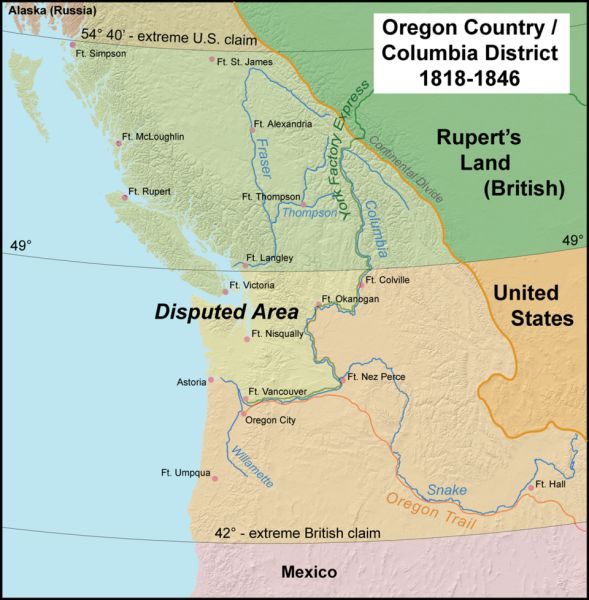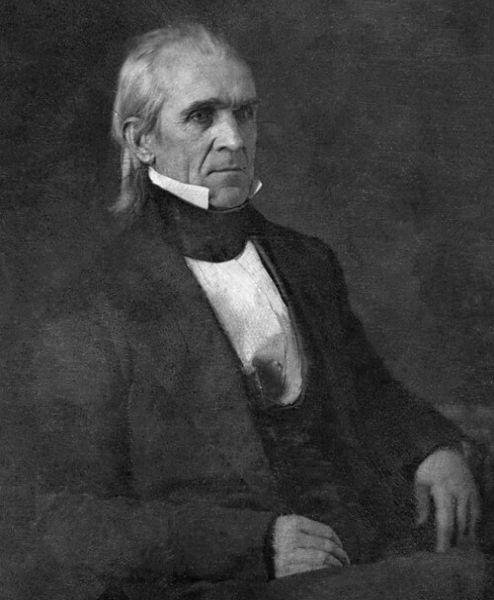In the early 1800s, the United States began to look westward with confidence. The Louisiana Purchase in 1803 doubled the nation's size. It also fueled the belief that expansion was key to America's future. By the 1840s, this belief had grown into a powerful ideology known as Manifest Destiny. Many Americans believed their country was meant to span from the Atlantic to the Pacific Ocean. Expansionism became more than a political goal. It was seen as the nation’s destiny.
One region at the center of this dream was the Oregon Territory. This large area included what we now call Oregon, Washington, and Idaho, along with land to the north. Both the United States and Great Britain claimed it. In 1818, the two nations decided to share the territory. They agreed on joint occupation. This compromise kept the peace for a time, but it did not solve the larger problem. As more settlers traveled west, the idea of sharing became harder to accept.

Map showing the disputed land in the Oregon Territory
In the 1830s and 1840s, thousands of Americans began the difficult journey along the Oregon Trail. Families, farmers, and missionaries traveled to the Willamette Valley after hearing about its rich and fertile land. By 1845, the number of American settlers outpaced the British in the region. Supporters of Manifest Destiny argued that this growth showed the land should belong to the United States, and the movement of settlers gave new energy to expansionist arguments.
The dispute of the Oregon Territory soon became a major test of Manifest Destiny. Both the United States and Great Britain continued to claim the territory, even as more Americans continued to move into the region. The issue became central in the 1844 presidential election, when Democratic candidate James K. Polk called for U.S. control of the entire Oregon Territory. His slogan, “Fifty-Four Forty or Fight,” captured the spirit of Manifest Destiny. It also appealed to voters who believed the nation’s future depended on westward growth. Polk’s victory showed how closely Americans tied expansion to both pride and opportunity.

Daguerrotype of James K. Polk, the 11ᵗʰ President of the United States (1849)
Tensions with Great Britain increased when Polk took office. Many Americans wanted to stand firm, while others feared a costly war. By 1846, the two sides reached an agreement. The Oregon Treaty set the boundary at the forty-ninth parallel. The United States got the southern section of the territory. This area had rich farmland and easy access to the Pacific Ocean. Expansionism had succeeded without a battle.
The dispute over the Oregon boundary showed how Manifest Destiny shaped American actions. Settlers, campaign slogans, and negotiations showed a strong belief in the U.S. destiny to expand. The resolution of 1846 was seen as another step toward that destiny.
Source: American Expansionism in the Northwest
- Brady, M. B. (1849, February 14). James Polk restored (cropped). Wikimedia Commons. https://commons.wikimedia.org/wiki/File:James_Polk_restored_(cropped)_(2).jpg
- HISTORY.com Editors. (2025, May 28). Westward Expansion - timeline, events & facts. HISTORY. https://www.history.com/articles/westward-expansion
- Kmusser. (2006, April 5). Oregon Country. https://commons.wikimedia.org/wiki/File:Oregoncountry.png
- Robinson, & Clarence, G. (2025, September 12). James K. Polk | Biography, Presidency, & Facts. Encyclopedia Britannica. https://www.britannica.com/biography/James-K-Polk/Presidency
- Rosenberg, M. (2025, May 12). Learn the History of the Battle for Oregon's Northern Border. ThoughtCo. https://www.thoughtco.com/fifty-four-forty-or-fight-1435388
- ushistory.org. (n.d.). 54° 40’ or fight. UShistory.org. https://www.ushistory.org/us/29b.asp?srsltid=AfmBOoo_NRjIM1nZAG8w6bOw4iIYEx4pzBQegkhepT--_z8d4XSBNb4V
